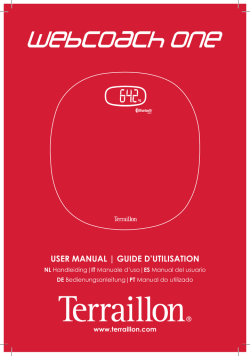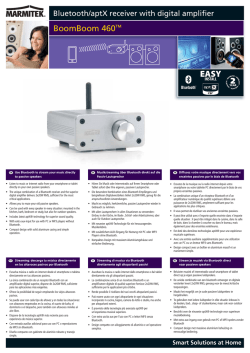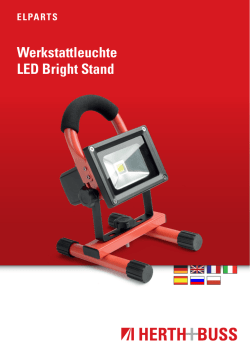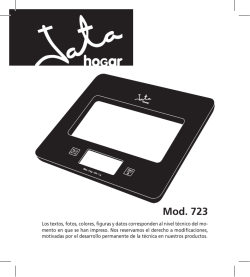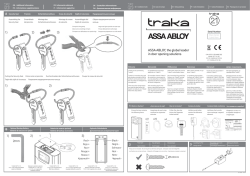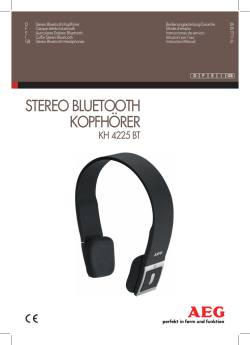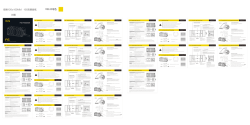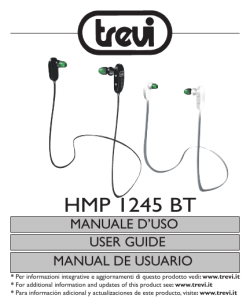
TransActive Wireless - User Guide
TransActive Wireless USER GUIDE ENGLISH ( 3 – 5 ) GUÍA DEL USUARIO ESPAÑOL ( 6 – 8 ) GUIDE D’UTILISATION FRANÇAIS ( 9 – 11 ) GUIDA PER L'USO ITALIANO ( 12 – 14 ) BENUTZERHANDBUCH DEUTSCH ( 15 – 17 ) USER GUIDE (ENGLISH) 1. 2. 3. 4. 5. 6. 7. 8. Make sure all items listed on the front of this guide are included in the box. READ SAFETY INSTRUCTION BOOKLET BEFORE USING THE PRODUCT. MAKE SURE THAT YOU HAVE COMPLETELY CHARGED THE BATTERY PRIOR TO FIRST USE FOR MAXIMUM BATTERY LIFE. Study this setup diagram. Make sure all input devices such as microphones, CD players, or MP3 players are turned off and volume settings are set at "zero." Connect all devices as shown. Switch everything on in the following order: • audio input sources (i.e. microphones, instruments, CD/MP3 Players) • TransActive Wireless When turning off, always reverse this operation: • TransActive Wireless • last, any input devices BOX CONTENTS TransActive Wireless Power Cable (standard IEC) User Guide Safety Instructions & Warranty Information Booklet Go to www.alesis.com for product registration. TOP PANEL TABLET OR OTHER DEVICE* REAR PANEL POWER MICROPHONE* *SOLD SEPARATELY RECHARGEABLE BATTERIES Rechargeable lead-acid batteries are the same type used in automobiles. As with your car battery, how you use this battery has a significant impact on its lifespan. With proper use and treatment, a lead-acid battery can last for years. Here are some recommendations for getting the longest life from the internal battery. GENERAL USAGE • FULLY CHARGE THE BATTERY BEFORE USING IT. • CHARGE THE BATTERY COMPLETELY AFTER EACH USE. • AVOID COMPLETELY DRAINING THE BATTERY. • You may leave the unit plugged in for up to two weeks. • For maximum life, drain the battery 80% once a month. STORAGE • • • REPAIR • Avoid storing in high temperatures and moist places. For long-term storage, periodically recharge the battery. If you do not charge the battery for six months, it may not charge. As the battery nears the end of its life, it may lose its ability to recharge. If this occurs, contact technical support at www.alesis.com/supporthome. DISPOSAL • Bring the unit to a recycling center or dispose of in accordance with local ordinances. iPad is a trademark of Apple Inc., registered in the U.S. and other countries. The Bluetooth word mark and logos are registered trademarks owned by Bluetooth SIG, Inc. and any use of such marks by Alesis is under license. Other trademarks and trade names are those of their respective owners. 3 DIAGRAM AND PARTS DESCRIPTION 7 8 1 1. 2. 3. 4. 2 3 4 3 5 6 Microphone Input with Volume Control (XLR-1/4"): This mono input accepts a XLR-1/4" input such as a microphone or other musical instrument. Instrument/Microphone Input with Volume Control: 1/4” TS input, highimpedance for guitar. Auxiliary Input with volume Control: This stereo 1/8” input can be used to connect a CD player, MP3 player, or other audio source. Volume control adjusts auxiliary input and Bluetooth volume. Bluetooth: The Paired LED will be lit when a device is paired to TransActive Wireless. This LED will not be lit when TransActive Wireless is first powered on (unless it was previously paired with a device). Press the Disconnect button to disconnect a paired Bluetooth device. Master Volume Control: This adjusts the speaker’s main mix volume, which includes Instrument/Microphone Input, Auxiliary Input, Tuner, and the audio of a paired Bluetooth device. Power LED: Indicates whether TransActive Wireless is on or off. Device Charge: Connect your device’s charge cable here to charge it. USB charging only functions when the unit’s power is turned on. Note: Users with iPad (3rd generation) may experience slower charging. We recommend charging with the *WARNING: If your unit has a voltage screen locked when using iPad (3rd generation). selector switch, change its setting only when Device Cradle: Place your iPad/iPod touch®/iPhone®, necessary (e.g., when traveling to a country Android® or other device here to be held. or region with a different voltage). Selecting Power Cable Input (IEC): Insert the included power an improper voltage setting can damage the cable here to charge the unit. Note that the TransActive unit. To change its setting, only remove *one* Wireless can run off the power adapter while it screw of the cover and slide it aside to simultaneously charges the battery. The charge indicator expose the selector. illuminates when the battery is charging. Voltage Selector*: If your unit has a voltage selector switch, change its setting only when necessary (e.g., when traveling to a country or region with a different voltage). Selecting an improper voltage setting can damage the unit. To change its setting, only remove *one* screw of the cover and slide it aside to expose the selector. Power ON/OFF Switch: Turns TransActive Wireless on or off. Please note that while TransActive Wireless is connected to a power source, it does not need to be powered on to charge the battery. Battery Level Indicator: While the unit is powered ON, these four lights indicate the power left in the battery. Battery life varies based on volume and usage. 12 5. 6. 7. 8. 9. 10. 11. 12. 11 9 iPhone and iPod touch are trademarks of Apple Inc., registered in the U.S. and other countries. Android is a trademark of Google Inc. 4 10 TROUBLESHOOTING If the sound is distorted: Try lowering the volume control of your sound source or musical instrument. Also, try to reduce the overall volume of TransActive Wireless. If there is too much bass: Try adjusting the tone or EQ control on your sound source to lower the bass level. This will allow you to play the music louder before clipping (distortion) occurs. If there is a high-pitched whistling noise when using microphones: This is probably feedback. Point the microphones away from the speaker. If you can’t hear the microphone over the music volume: Turn down the music volume from your source. PAIRING A BLUETOOTH DEVICE 1. 2. 3. 4. 5. 6. 7. Turn on your Bluetooth device. Power on TransActive Wireless and it will automatically go into pairing mode to search for Bluetooth devices. You will know you are in pairing mode when the LED is blank. If your Bluetooth device is not able to pair to TransActive Wireless, press the disconnect button on TransActive Wireless to break previous Bluetooth connections and reset the Bluetooth module. Navigate to your Bluetooth device’s setup screen, find “Alesis TransAct” and connect. Note: If your Bluetooth device prompts for a pairing code, enter ‘0000’. TransActive Wireless LED will light up solid when it is 'paired'. Note: Users should consider updating their OS if experiencing trouble with pairing or playing music. To disconnect pairing, press the ‘Disconnect’ button on TransActive Wireless. To connect to another Bluetooth device, repeat steps 3-4. Note: Maximum range will be achieved when using devices with Bluetooth 4.0. 5 GUÍA DEL USUARIO (ESPAÑOL) 1. 2. 3. 4. 5. 6. 7. 8. Asegúrese que todos los artículos incluidos al inicio de este guía estén incluidos en la caja. CONTENIDO DE LA CAJA LEA LAS INSTRUCCIONES DEL FOLLETO DE SEGURIDAD TransActive Wireless ANTES DE UTILIZAR EL PRODUCTO. ASEGÚRESE DE QUE HA CARGADO COMPLETAMENTE LA Cable de alimentación BATERÍA. PARA LOGRAR LA MÁXIMA VIDA ÚTIL DE LA Guía del usuario BATERÍA, CÁRGUELA TOTALMENTE ANTES DEL PRIMER Folleto de información sobre la seguridad USO. y la garantía Estudie este diagrama de instalación. Asegúrese de que todos los dispositivos de entrada tales como micrófonos, reproductores de CD, o reproductores MP3 estén apagados y con el control de volumen en "cero". Conecte todos los dispositivos como se muestra. Encienda todo en el siguiente orden: • fuentes de entrada de audio (por ejemplo, micrófonos, instrumentos, reproductores de CD/MP3) • TransActive Wireless Al apagar, realice siempre esta operación en sentido inverso: • TransActive Wireless Visite www.alesis.com para • por último, cualquier dispositivo de entrada registrar el producto. PANEL SUPERIOR TABLET U OTRO DISPOSITIVO * PANEL LATERAL SUMINISTRO ELÉCTRICO MICRÓFONO* *SE VENDE POR SEPARADO BATERÍAS RECARGABLES Las baterías de plomo-ácido recargables son del mismo tipo que se usa en los automóviles. Al igual que con la batería del vehículo, la forma en que se usa tiene una influencia significativa en la duración de su vida útil. Con un uso y tratamiento correctos, una batería de plomo-ácido puede durar varios años. He aquí algunas recomendaciones para prolongar la vida útil de la batería interna. USO GENERAL • CARGUE COMPLETAMENTE LA BATERÍA ANTES DE USARLA. • CARGUE LA BATERÍA COMPLETAMENTE DESPUÉS DE CADA USO. • EVITE AGOTARLA COMPLETAMENTE. • Puede dejar la unidad enchufada durante hasta dos semanas. • Para obtener máxima vida, descargue la batería el 80% una vez por mes. ALMACENAMIENTO • Evite almacenar la batería en lugares húmedos y de alta temperatura. • Si la almacena durante períodos prolongados, recárguela periódicamente. • Si no carga la batería durante seis meses, es posible que luego no pueda cargarse. REPARACIÓN • Cuando la batería se acerca al final de su vida útil, puede perder su capacidad de recarga. Si esto ocurre, comuníquese con el soporte técnico de Alesis al www.alesis.com/supporthome. DISPOSICIÓN FINAL • Lleve la unidad a un centro de reciclaje o deséchela de acuerdo a las ordenanzas locales. 6 DIAGRAMA Y DESCRIPCIÓN 7 8 1 1. 2. 3. 4. 5. 6. 7. 8. 9. 10. 11. 12. 2 3 4 3 5 6 Entrada de instrumento / Micrófono con control de volumen (XLR1/4"): Esta entrada mono admite una entrada de XLR-1/4" tal como un micrófono u otro instrumento musical. Entrada para instrumento/micrófono con control de volumen: Entrada TS de 1/4 pulg, de alta impedancia para guitarra. Entrada auxiliar con control de volumen: Esta entrada de 1/8" estéreo se puede usar para conectar un reproductor de CD, MP3 u otra fuente de audio. El control de volumen ajusta la entrada auxiliar y el volumen de Bluetooth. Bluetooth: El LED Paired (Apareado) se enciende cuando se aparea un dispositivo al TransActive Wireless. Este LED no se enciende cuando el TransActive Wireless se enciende por primera vez (a menos que hubiera sido apareado previamente con un dispositivo). Pulse el botón Disconnect (Desconectar) para desconectar un dispositivo Bluetooth apareado. Control de volumen maestro: Este control ajusta el volumen de la mezcla principal del altavoz, que incluye la entrada de instrumento/micrófono, la entrada auxiliar, el sintonizador y el audio de un dispositivo Bluetooth apareado. LED de encendido: Indica cuando el TransActive Wireless está encendido o apagado. * ADVERTENCIA: Carga del dispositivo: Conecte aquí el cable de carga Si su unidad cuenta con un conmutador de su dispositivo para cargarlo. La carga por USB selector de voltaje, cambie el ajuste del funciona solamente cuando la unidad está encendida. mismo sólo cuando sea necesario (por ej., Nota: Los usuarios de iPad (3ra generación) pueden cuando viaje a un país o región con un voltaje experimentar una carga más lenta. Recomendamos diferente). Si selecciona un ajuste de voltaje cargar con la pantalla bloqueada cuando se usa iPad incorrecto, se puede dañar la unidad. Para (3ra generación). cambiar este ajuste, sólo retire *un* tornillo de Base del dispositivo: Coloque aquí su iPad/iPod la cubierta y deslícela a un lado para exponer touch/iPhone, Android u otro dispositivo a sostener. el selector. Entrada del cavo de alimentación (IEC): Inserte aquí el cable de alimentación incluido para cargar la unidad. Tenga en cuenta que el amplificador portátil para altavoces puede funcionar con el adaptador de potencia mientras se carga simultáneamente la batería. El indicador de carga se enciende cuando se está cargando la batería. Selector de voltaje*: Si su unidad cuenta con un conmutador selector de voltaje, cambie el ajuste del mismo sólo cuando sea necesario (por ej., cuando viaje a un país o región con un voltaje diferente). Si selecciona un ajuste de voltaje incorrecto, se puede dañar la unidad. Para cambiar este ajuste, sólo retire *un* tornillo de la cubierta y deslícela a un lado para exponer el selector. Interruptor de encendido/apagado: Enciende y apaga el TransActive Wireless. Tenga en cuenta que mientras el TransActive Wireless está conectado a un suministro eléctrico, no es necesario encenderlo para que cargue la batería. Indicador de nivel de batería: Mientras la unidad está alimentada, estas cuatro luces indican la energía remanente en la batería. La vida útil de la batería varía en función del volumen y el consumo. 12 11 9 7 10 SOLUCIÓN DE PROBLEMAS Si el sonido está distorsionado: Pruebe bajando el control de volumen de su fuente de sonido o instrumento musical. Pruebe también reduciendo el volumen general del TransActive Wireless. Si hay demasiados graves: Intente ajustando el control de tono o ecualización de su fuente de sonido para reducir el nivel de graves. De esta forma podrá reproducir la música con más volumen antes de que se produzca el recorte (distorsión). Si hay un silbido agudo cuando se usan micrófonos: Probablemente sea realimentación. Apunte los micrófonos apartándolos del altavoz. CÓMO APAREAR UN DISPOSITIVO BLUETOOTH 1. 2. 3. 4. 5. 6. 7. Encienda su dispositivo Bluetooth. Encienda el TransActive Wireless, que pasará automáticamente al modo de apareamiento para buscar dispositivos Bluetooth. Se dará cuenta de que está en modo de apareamiento cuando el LED está apagado. Si su dispositivo Bluetooth no es capaz de aparearse con TransActive Wireless, pulse el botón de desconexión del TransActive Wireless para romper las conexiones Bluetooth anteriores y reinicie el módulo Bluetooth. Navegue a la pantalla de configuración de su dispositivo Bluetooth, busque “Alesis TransAct” y conecte. Nota: Si su dispositivo Bluetooth solicita un código de apareamiento, ingrese ‘0000’. El LED TransActive Wireless se enciende con luz permanente cuando está 'apareado'. Nota: Los usuarios deben considerar la actualización de su sistema operativo (OS) si experimentan problemas con el apareamiento o la reproducción de música. Para desconectar el apareamiento, pulse el botón ‘Disconnect’ del TransActive Wireless. Para conectarse a otro dispositivo Bluetooth, repita los pasos 3 y 4. Nota: El alcance máximo se logra cuando se utilizan dispositivos con Bluetooth 4.0. 8 GUIDE D'UTILISATION (FRANÇAIS) 1. 2. 3. 4. 5. 6. 7. 8. Assurez-vous que tous les articles énumérés sur la page couverture de ce guide sont inclus dans la boîte. CONTENU DE LA BOÎTE VEUILLEZ LIRE LE LIVRET DES CONSIGNES DE SÉCURITÉ TransActive Wireless AVANT D'UTILISER LE PRODUIT. VEUILLEZ VOUS ASSURER QUE LA PILE EST COMPLÈTEMENT Câble d'alimentation RECHARGÉE. RECHARGER COMPLÈTEMENT LA PILE AVANT Guide d'utilisation LA PREMIÈRE UTILISATION AFIN D'AUGMENTER SA DURÉE DE Le livret des consignes de sécurité et VIE. des informations concernant la garantie Examinez bien le schéma d'installation. Assurez-vous que tous les appareils d'entrée tels que microphones, lecteur de disques compacts, lecteur MP3 ou les autres appareils branchés sont hors tension et que leur volume soit réglé à « zéro ». Connectez tous les appareils tel qu'indiqué sur le schéma. Mettre tous les appareils sous tension dans l'ordre suivant. • source d'entrée audio (p. ex. microphones, instruments, lecteurs CD/MP3) • TransActive Wireless Pour mettre hors tension, toujours inverser l'opération: • TransActive Wireless Allez à la www.alesis.com pour • en dernier, tous les appareils d'entrée l'enregistrement du produit. PANNEAU SUPÉRIEUR TABLETTE OU AUTRE APPAREIL* PANNEAU LATÉRAL ALIMENTATION MICROPHONE* *VENDU SÉPARÉMENT PILES RECHARGEABLES Les piles au plomb rechargeables sont du même type que les batteries utilisées dans les automobiles. Comme pour la batterie de votre automobile, la manière dont vous l'utilisez a un impact direct sur sa durée de vie. Cependant, avec une bonne utilisation la pile au plomb peut avoir une durée de vie de plusieurs années. Voici quelques recommandations pour prolonger au maximum la durée de vie de la pile interne. UTILISATION GÉNÉRALE • CHARGEZ COMPLÈTEMENT LA PILE AVANT DE L'UTILISER. • RECHARGEZ LA PILE COMPLÈTEMENT APRÈS CHAQUE UTILISATION. • ÉVITEZ DE DÉCHARGER LA PILE COMPLÈTEMENT. • L'appareil peut demeurer branché jusqu'à deux semaines. • Afin de prolonger la durée de vie, déchargez la pile à 80 % une fois par mois. ENTREPOSAGE • Évitez d'exposer l'appareil à de hautes températures et à l'humidité. • Durant l'entreposage à long terme, rechargez la pile régulièrement. • S'il se passe plus de six mois sans que la pile soit rechargée, il se pourrait qu'elle ne se recharge plus. RÉPARATION • Il se peut que la capacité de recharge de la pile se détériore plus elle se rapproche de la fin de sa durée de vie. Si cela. se produit, veuillez communiquer avec le service technique de Alesis au www.alesis.com/supporthome. DISPOSER • Apportez l'appareil dans un centre de recyclage ou disposez selon les règlements de votre municipalité. 9 SCHÉMA ET DESCRIPTION 7 8 1 1. 2. 3. 4. 5. 6. 7. 8. 9. 10. 11. 12. 2 3 4 3 5 6 Entrée instrument / microphone avec commande de volume (XLR1/4 po) : Cette entrée mono peut accueillir un câble de XLR-1/4 po pour microphone ou un autre instrument de musique. Entrée instrument/microphone avec commande de volume : Entrée TS 1/4 po à haute impédance pour guitare. Entrée auxiliaire avec commande de volume : Cette entrée stéréo 1/8 po permet de brancher un lecteur CD, un lecteur MP3 ou autres sources audio. Commande de volume règle les niveaux de l’entrée auxiliaire et Bluetooth. Bluetooth : La DEL de jumelage sera allumée lorsqu'un périphérique est jumelé au TransActive Wireless. Cette DEL ne sera pas allumée lorsque le TransActive Wireless est d'abord alimenté (à moins qu'il a été jumelé avec un périphérique auparavant). Appuyez sur le d'un périphérique Bluetooth jumelé. Volume général: Ce bouton permet de régler le volume du mix général qui comprend l'entrée instrument/microphone, l’entrée auxiliaire, le syntoniseur et l'audio d'un périphérique Bluetooth jumelé. Témoin d'alimentation DEL: Indique si le TransActive Wireless est sous ou hors tension. * MISE EN GARDE: Dispositif de recharge : Branchez le câble de Si votre appareil dispose d’un sélecteur de rechargement de votre périphérique à cette prise pour tension, changez seulement le réglage si le recharger. Le rechargement de la pile par la nécessaire (par exemple, en voyageant dans un connexion USB fonctionne uniquement lorsque pays ou une région avec une tension différente). l’appareil est allumé. L'utilisation d’une tension inappropriée pourrait Remarque : Les utilisateurs du iPad de 3e génération endommager l’appareil. Pour modifier le réglage, peuvent éprouver un temps de rechargement de pile retirez uniquement *une* des vis du couvercle et plus long. Pour le iPad de 3e génération, nous faites-le glisser afin d’accéder au sélecteur. recommandons de verrouiller l’écran lors du rechargement de la pile. Station d’accueil : Placez votre iPad/iPod touch/iPhone, Android ou autre dispositif sur ce socle. Entrée du câble d'alimentation (IEC) : Brancher le câble d'alimentation ci-inclus ici pour recharger l'appareil. Sachez qu'il est possible d'utiliser le système PA portable tout en le rechargeant à l'aide de l'adaptateur d'alimentation. L'indicateur de charge s'allume lorsque la pile se recharge. Sélecteur de tension* : Si votre appareil dispose d’un sélecteur de tension, changez seulement le réglage si nécessaire (par exemple, en voyageant dans un pays ou une région avec une tension différente). L'utilisation d’une tension inappropriée pourrait endommager l’appareil. Pour modifier le réglage, retirez uniquement *une* des vis du couvercle et faites-le glisser afin d’accéder au sélecteur. Interrupteur Marche/Arrêt: Permet de mettre le TransActive Wireless sous et hors tension. Veuillez noter que lorsque le TransActive Wireless est branché à une source d’alimentation, il peut recharger la pile sans être sous tension. Indicateur de niveau de charge : Lorsque l'appareil est sous tension, ces quatre témoins indiquent le niveau de charge de la pile. La durée de vie de la pile dépend de l'utilisation de l'appareil et du réglage du niveau du volume. 12 11 9 10 10 GUIDE DE DÉPANNAGE Lorsqu’il y a de la distorsion : Essayez de diminuer le volume sur l’appareil d’entrée audio ou l’instrument de musique. Essayez également de réduire le volume général du TransActive Wireless. Lorsqu’il y a trop de basses fréquences : Essayez de régler le niveau de tonalité et d’égalisation sur l’appareil de source d’entrée audio afin de diminuer le niveau des basses fréquences. Cela vous permettra d'augmenter le volume de la musique avant que l'écrêtage se produise. Lorsqu’il y a un sifflement aigu lors de l’utilisation des microphones : Ceci est probablement causé par l’effet Larsen (feedback). Dirigez les microphones loin des haut-parleurs. JUMELAGE D'UN PÉRIPHÉRIQUE BLUETOOTH 1. 2. 3. 4. 5. 6. 7. Mettez votre périphérique Bluetooth sous tension. Mettez le TransActive Wireless sous tension et il passera automatiquement en mode jumelage afin de rechercher les périphériques Bluetooth. Vous saurez que vous êtes en mode jumelage lorsque la DEL devient blanche. Si votre périphérique Bluetooth ne parvient pas à se jumeler à TransActive Wireless, appuyez sur le bouton Disconnect de TransActive Wireless afin de supprimer la connexion à d'autres périphériques Bluetooth et remettre à zéro le module Bluetooth. Accédez à l'écran de configuration de votre périphérique Bluetooth, recherchez «Alesis TransAct» et lancez le jumelage. Remarque : Si votre périphérique Bluetooth vous demande d’entrer un code de jumelage, entrez « 0000 ». La DEL du TransActive Wireless’s allumera lorsque le jumelage est réussi. Remarque : Les utilisateurs devraient envisager de mettre à jour leur système d'exploitation si des ennuis surviennent durant le jumelage ou lors de la lecture de musique. Appuyez sur le bouton Disconnect du TransActive Wireless pour déconnecter le périphérique Bluetooth branché. Pour jumeler un autre périphérique Bluetooth, répétez les étapes 3 et 4. Remarque : La plage maximale peut être atteinte avec l’utilisation d’appareils dotés de Bluetooth 4.0. 11 GUIDA PER L'USO (ITALIANO) 1. 2. 3. 4. 5. 6. 7. 8. Verificare che tutti gli elementi elencati sul frontespizio di questa guida siano inclusi nella confezione. CONTENUTI DELLA CONFEZIONE PRIMA DI UTILIZZARE IL PRODOTTO LEGGERE IL LIBRETTO DELLE TransActive Wireless ISTRUZIONI DI SICUREZZA. Cavo di alimentazione ASSICURARSI DI AVER CARICATO COMPLETAMENTE LA BATTERIA. CARICARE TOTALMENTE LA BATTERIA PRIMA DEL Guida per l'uso PRIMO UTILIZZO PER GARANTIRNE LA MASSIMA DURATA. Libretto di istruzioni di sicurezza e Esaminare attentamente lo schema di montaggio. garanzia Assicurarsi che tutti i dispositivi d'ingresso quali microfoni, lettori CD, o lettori MP3 collegati siano spenti e che il volume sia impostato su "zero" Collegare tutti i dispositivi come illustrato. Accendere tutto nel seguente ordine: • sorgenti di ingresso audio (microfoni, strumenti, lettori CD/MP3) • TransActive Wireless Al momento dello spegnimento, invertire l'operazione: Recarsi sul sito www.alesis.com per la • TransActive Wireless registrazione del prodotto. • per ultimi, tutti i dispositivi di ingresso PANNELLO SUPERIORE TABLET O ALTRI DISPOSITIVI* PANNELLO LATERALE ALIMENTAZIONE MICROFONO* *VENDUTI SEPARATAMENTE BATTERIE RICARICABILI Le batterie ricaricabili al piombo-acido sono dello stesso tipo di quelle utilizzate nelle automobili. Come nel caso della batteria dell'auto, la maniera in cui si utilizza questa batteria ha un notevole impatto sulla sua vita utile. Con un utilizzo adeguato, una batteria al piombo-acido può durare per anni. Ecco alcune raccomandazioni per garantire la massima durata dalla batteria interna: UTILIZZO GENERICO • CARICARE A FONDO LA BATTERIA PRIMA DI UTILIZZARLA. • CARICARE A FONDO LA BATTERIA DOPO CIASCUN UTILIZZO. • EVITARE DI SCARICARE DEL TUTTO LA BATTERIA. • È possibile lasciare l'apparecchio collegato alla rete elettrica per un massimo di due settimane. • Per il massimo della durata, scaricare la batteria dell'80% una volta al mese. COME RIPORRE L'APPARECCHIO • Evitare di riporre l'apparecchio a temperature elevate e in luoghi umidi. • Se si ripone l'apparecchio per lunghi periodi di tempo, ricaricare periodicamente la batteria. • Se non si carica la batteria per sei mesi, potrebbe non ricaricarsi più. RIPARAZIONI • Man mano che la batteria si avvicina al termine della sua vita utile, può perdere la capacità di ricarica. Se ciò accade, contattare il servizio di assistenza tecnica di Alesis al www.alesis.com/supporthome. COME ELIMINARE L'APPARECCHIO • Recarsi con l'apparecchi presso un centro di riciclaggio oppure eliminarlo in conformità con le normative locali. 12 DIAGRAMMA E DESCRIZIONE 7 8 1 1. 2. 3. 4. 5. 6. 7. 8. 9. 10. 11. 12. 2 3 4 3 5 6 Ingresso strumento / microfono con controllo di guadagno volume (XLR-1/4"): questo ingresso mono accetta un ingresso da XLR-1/4" quali un microfono o altro strumento musicale. Ingresso strumenti/microfono con comando di regolazione del Volume: Ingresso TS da 1/4” ad elevata impedenza per chitarra. Ingresso ausiliario con comando di regolazione del Volume: questo ingresso stereo da 1/8" può essere utilizzato per collegare un lettore CD, un lettore MP3 o altre sorgenti audio. Il comando di regolazione del Volume regola il volume dell'ingresso ausiliario e Bluetooth. Bluetooth: il LEDaccoppiato sarà acceso quando un dispositivo è accoppiato al TransActive Wireless. Il LED non sarà acceso quando il TransActive Wireless viene acceso (a meno che non fosse accoppiato in precedenza con un dispositivo). Premere il pulsante Disconnect (scollega) per scollegare di un dispositivo Bluetooth accoppiato. Comando volume Master: questo comando regola il volume principale di mix dell'altoparlante, che comprende l'ingresso strumento/microfono, l'ingresso ausiliario (aux), il sintonizzatore e l'audio di un dispositivo Bluetooth accoppiato. LED di alimentazione: indica se il TransActive Wireless * AVVERTENZA: Se l'apparecchio dispone di è acceso o spento. un interruttore selettore di voltaggio, Dispositivo di carica: collegare a questo livello il cavo modificarne l'impostazione solo se necessario di ricarica del dispositivo per ricaricarlo. La carica tramite (quando ci si reca in un Paese o in una USB funziona unicamente quando l'apparecchio è regione dove viene impiegato un voltaggio acceso. diverso). L'impostazione di un voltaggio errato Nota bene: gli utenti di iPad (3ª generazione) può danneggiare l'apparecchio. Per modificare potrebbero notare una ricarica più lenta. Quando si l'impostazione, rimuovere solo *una* vite dal utilizza l'iPad (3ª generazione), si consiglia di caricare coperchio e farlo scorrere di lato per esporre il con lo schermo bloccato. selettore. Cradle del dispositivo: collocare l'iPad/iPod touch/iPhone, Android o altro dispositivo a questo livello per essere supportato. Ingresso cavo di alimentazione (IEC): inserire il cavo di alimentazione in dotazione per caricare l'apparecchio. Il TransActive Wireless può funzionare con l'adattatore anche durante la ricarica della batteria. L'indicatore di carica si illumina durante la ricarica stessa. Selettore di voltaggio*: se l'apparecchio dispone di un interruttore selettore di voltaggio, modificarne l'impostazione solo se necessario (quando ci si reca in un Paese o in una regione dove viene impiegato un voltaggio diverso). L'impostazione di un voltaggio errato può danneggiare l'apparecchio. Per modificare l'impostazione, rimuovere solo *una* vite dal coperchio e farlo scorrere di lato per esporre il selettore. Interruttore di alimentazione ON/OFF: accende o spegne il TransActive Wireless. Va notato che quando il TransActive Wireless è collegato ad una fonte di alimentazione, non deve essere necessariamente acceso per caricare la batteria. Indicatore di livello batteria: ad apparecchio acceso (ON), queste quattro luci indicano la carica residua della batteria. La durata della batteria dipende dal volume e dall'uso. 12 11 9 13 10 RISOLUZIONE DI PROBLEMI Il suono è distorto: provare ad abbassare il volume della propria fonte audio o dello strumento musicale. Inoltre, provare a ridurre il volume complessivo del TransActive Wireless. Eccessivi bassi: provare a regolare la tonalità o il comando EQ a livello della fonte audio per abbasare il livello dei bassi. Ciò permetterà di suonare la musica più forte prima che salti (che si verifichi distorsione). Quando si utilizzano i microfoni si verifica un fischio ad alto pitch: si tratta probabilmente di ritorno. Puntare i microfoni lontani dalle casse. ACCOPPIAMENTO DI UN DISPOSITIVO BLUETOOTH 1. 2. 3. 4. 5. 6. 7. Accendere il dispositivo Bluetooth. Accendere il TransActive Wireless: entrerà automaticamente in modalità di accoppiamento per cercare dispositivi Bluetooth. Siete in modalità di accoppiamento quando il LED è bianco. Se il dispositivo Bluetooth non è in grado di allinearsi con TransActive Wireless, premere il tasto di scollegamento sull'amp per interrompere precedenti collegamenti Bluetooth e resettare il modulo Bluetooth. Navigare nella schermata di configurazione del dispositivo Bluetooth, trovare “Alesis TransAct” e collegarlo. Nota bene: se il dispositivo Bluetooth richiede un codice, inserire ‘0000’. Il LED del TransActive Wireless rimarrà illuminato quando è "accoppiato". Nota bene: Gli utenti dovrebbero aggiornare il loro sistema operativo in caso di problemi con l'accoppiamento o con la riproduzione di musica. Per annullare il collegamento, premere il pulsante "Disconnect" (scollega) su TransActive Wireless. Per collegarlo ad un altro dispositivo Bluetooth, ripetere i passaggi 3-4. Nota bene: la portata massima sarà raggiunta utilizzando dispositivi dotati di Bluetooth 4.0. 14 BENUTZERHANDBUCH (DEUTSCH) 1. 2. 3. 4. 5. 6. 7. 8. Überprüfen Sie, ob sich alle auf dem Deckblatt genannten Teile in der Verpackung befinden. LESEN SIE DIE SICHERHEITSHINWEISE, BEVOR SIE DIESES PRODUKT VERWENDEN. LADEN SIE DIE BATTERIE VOR DER ERSTEN VERWENDUNG AUF, UM DIE LEBENSDAUER DER BATTERIE ZU MAXIMIEREN. Sehen Sie sich die Aufbauabbildung an. Schalten Sie alle Eingangsquellen (Mikrofone, CD Player, oder MP3 Player) aus und drehen Sie deren Lautstärke auf "Null." Verbinden Sie zusätzliche Geräte wie unten abgebildet. Schalten Sie das System in der folgenden Reihenfolge ein: • Eingangsquellen (z.B. Mikrofon, Instrumente und/oder CD-Player) • TransActive Wireless Gehen Sie beim Ausschalten in der genau umgekehrten Reihenfolge vor: • TransActive Wireless • Und zuletzt die Eingangsquellen INHALT DER VERPACKUNG TransActive Wireless Netzkabel Benutzerhandbuch Broschüre mit den Sicherheitsund Garantierichtlinien Registrieren Sie Ihr Produkt online unter www.alesis.com OBERSEITE TABLET ODER ANDERES GERÄT* SEITENTEIL STROM MIKROFON* *SEPARAT ERHÄLTLICH WIEDERAUFLADBARE BATTERIEN Bei wiederaufladbaren Bleibatterien handelt es sich um die gleiche Art von Batterien, die in Autos verwendet werden. Und wie bei Ihrer Autobatterie ist es auch für die Benutzungsdauer dieser Batterie von äußerster Wichtigkeit, wie sie verwendet wird. Bei vorschriftsmäßigem Gebrauch und richtiger Pflege kann eine Bleibatterie jahrelang halten. Lesen Sie die nachstehenden Empfehlungen, um aus der eingebauten Batterie das Beste herauszuholen. ALLGEMEINE GEBRAUCHSHINWEISE • BATTERIE VOR GEBRAUCH IMMER VOLL AUFLADEN. • BATTERIE NACH JEDEM GEBRAUCH VOLL AUFLADEN. • VÖLLIGES ENTLEEREN DER BATTERIE SOLLTE VERMIEDEN WERDEN. • Halten Sie das Gerät nicht dauerhaft am Stromnetz (maximal 2 Wochen), benutzen Sie das Gerät regelmäßig im Batteriebetrieb. • Um die maximale Benutzungsdauer auszuschöpfen, sollte die Batterie wenigstens einmal im Monat zu 80% entleert warden. AUFBEWAHRUNG • Gerät nicht hohen Temperaturen oder feuchter Umgebung aussetzen. • Bei Langzeitaufbewahrung Batterie in regelmäßigen Abständen aufladen. • Wird die Batterie sechs Monate lang nicht geladen, kann sie unter Umständen nicht mehr aufgeladen warden. REPARIEREN • Mit zunehmendem Alter der Batterie nimmt unter Umständen deren Ladefähigkeit ab. Wenn dies eintritt, wenden Sie sich an den technischen Support von Alesis unter www.alesis.com/supporthome. ENTSORGUNG • Batterie zu einem Wiederverwertungszentrum bringen oder im Rahmen der geltenden Vorschriften entsorgen. 15 BEDIENELEMENTE 7 8 1 1. 2. 3. 4. 5. 6. 7. 8. 9. 10. 11. 12. 2 3 4 3 5 6 Instrument / Mikrofon Eingang mit Lautstärke-Regler (XLR-1/4”): Dieser Mono Eingang ist kompatibel mit normalen Klinkenkabeln von einem Mikrofon oder einem anderen Musikinstrument. Instrument-/Mikrofoneingang mit Lautstärkeregler: Hochohmiger 1/4" TS-Eingang für Gitarre. Auxiliary-Eingang mit Lautstärkeregler: Dieser 1/8”-Eingang (Stereo) kann dazu verwendet werden, einen CD-Player, MP3-Player oder eine andere Audioquelle anzuschließen. Lautstärkeregler für Aux-Eingang und Bluetooth-Lautstärke. Bluetooth: Die Koppel-LED leuchtet, wenn ein Gerät mit dem TransActive Wireless gekoppelt ist. Diese LED leuchtet nicht, wenn der TransActive Wireless zum ersten Mal eingeschaltet wird (es sei denn, er wurde zuvor mit einem Gerät gekoppelt). Drücken Sie die Taste Trennen, um ein angeschlossenes Bluetooth-Gerät zu trennen. Gesamtlautstärkeregler: Regelt die Gesamtlautstärke des Lautsprechers. Dies beinhaltet den Instrument-/Mikrofon-Eingang, den AUX-Eingang, den Tuner und das Audiosignal eines gekoppelten Bluetooth-Geräts. Power-LED: Zeigt an, ob TransActive Wireless ein- oder ausgeschaltet ist. * ACHTUNG: Geräts-aufladen: Schließen Sie das Ladekabel Ihres Wenn Ihr Gerät über einen Wahlschalter Geräts hier an, um es aufzuladen. Das Laden via USB verfügt, sollten Sie nur dann Änderungen funktioniert nur, wenn das Gerät eingeschaltet ist. vornehmen, wenn es notwendig ist (z.B. wenn Hinweis: Bei iPads der 3. Generation dauert das Sie in ein Land oder eine Region mit Aufladen möglicherweise länger. Bei iPads der 3. unterschiedlicher Spannung reisen). Die Wahl Generation empfehlen wir, den Ladevorgang bei der falschen Spannung kann das Gerät gesperrtem Bildschirm durchzuführen. beschädigen. Um die Einstellung zu ändern, Dockingstation: Setzen Sie Ihr iPad/iPod touch/iPhone, entfernen Sie nur *eine* Schraube der Android oder ein anderes Gerät in diese Halterung. Abdeckung und schieben Sie sie beiseite, um Netzkabel-Eingang (IEC): Schließen Sie hier das den Wähler freizulegen. mitgelieferte Netzkabel zum Laden der Batterie an. Der TransActive Wireless kann mit dem Netzkabel betrieben werden und gleichzeitig die Batterie laden. Die Ladekontroll-LED leuchtet, sobald die Batterie aufgeladen wird. Voltauswahl*: Wenn Ihr Gerät über einen Wahlschalter verfügt, sollten Sie nur dann Änderungen vornehmen, wenn es notwendig ist (z.B. wenn Sie in ein Land oder eine Region mit unterschiedlicher Spannung reisen). Die Wahl der falschen Spannung kann das Gerät beschädigen. Um die Einstellung zu ändern, entfernen Sie nur *eine* Schraube der Abdeckung und schieben Sie sie beiseite, um den Wähler freizulegen. Power ON/OFF Schalter: Schaltet den TransActive Wireless an oder aus. Beachten Sie bitte, dass beim Anschluss des TransActive Wireless an ein Stromnetz das Gerät nicht eingeschaltet werden muss, um die Batterie aufzuladen. Batteriestand-LEDs: Wenn das Gerät eingeschaltet wird, zeigen diese vier LEDs an, wie viel Spannung in der Batterie vorhanden ist. Die Laufzeit der Batterie variiert auf Grund von Lautstärke und Betriebsdauer. 12 11 9 16 10 FEHLERBEHEBUNG Der Ton klingt verzerrt: Drehen Sie den Lautstärkeregler an Ihrer Tonquelle oder dem Musikinstrument zurück. Versuchen Sie auch, die Gesamtlautstärke des TransActive Wireless zu reduzieren. Zu viel Bass: Versuchen Sie, den Ton- oder EQ-Regler Ihrer Tonquelle anzupassen, um den Bass zu verringern. Dies ermöglicht Ihnen, die Musik lauter abzuspielen, bevor der Klang verzerrt. Bei der Verwendung von Mikrofonen tritt einer hoher Pfeifton auf: Hier handelt es sich wahrscheinlich um einen Rückkopplungseffekt. Richten Sie es so ein, dass die Mikrofone vom Lautsprecher wegzeigen. KOPPELN EINES BLUETOOTH-GERÄTS 1. 2. 3. 4. 5. 6. 7. Schalten Sie Ihr Bluetooth-Gerät ein. Schalten Sie TransActive Wireless ein und das Gerät wird automatisch in den Koppel-Modus schalten, um nach Bluetooth-Geräten zu suchen. Sie sind im Koppel-Modus, wenn die LED nicht leuchtet. Wenn Ihr Bluetooth-Gerät nicht an TransActive Wireless gekoppelt werden kann, drücken Sie am TransActive Wireless die Taste Trennen, um alte Bluetooth-Verbindungen zu trennen und das Bluetooth-Modul zurückzusetzen. Navigieren Sie zum Setup-Bildschirm Ihres Bluetooth-Geräts, suchen Sie "Alesis TransAct” und verbinden Sie die Geräte. Hinweis: Wenn Ihr Bluetooth-Gerät die Eingabe eines Koppel-Codes anfordert, geben Sie '0000' ein. Die TransActive Wireless LED wird durchgehend leuchten, wenn die Geräte "gekoppelt" sind. Hinweis: Benutzer sollten die Aktualisierung ihres OS in Betracht ziehen, falls sie Probleme beim Koppeln oder bei der Musikwiedergabe haben. Wenn Sie die Geräte entkoppeln möchten, drücken Sie die Taste "Trennen" am TransActive Wireless. Um ein anderes Bluetooth-Gerät zu verbinden, wiederholen Sie die Schritte 3-4. Hinweis: Die maximale Reichweite wird erreicht, wenn Sie Geräte mit Bluetooth 4.0 verwenden. 17 SPECIFICATIONS Power Supply: 110-120 V ~ 60 Hz; Fuse: T750 mAL, AC 250 V 220-240 V ~ 50 Hz; Fuse: T315 mAL, AC 250 V Microphone type: Dynamic microphone Bottom pole mount specifications: Standard pole mount found at professional audio retailer: Depth 80 mm (3.15") Diameter 35.5 mm (1.40") Time required to fully charge TransActive Wireless: Approximately 6 hours Battery life: Up to 50 hours* when fully charged. *Note: Battery life may vary based on temperature, age, and volume usage of product. Supported Bluetooth Profile: A2DP Dimensions: (LxWxH): 14.5" x 10.6" x 17"; 368.3 mm x 269.2 mm x 431.8 mm Weight: 28.05 lb.; 12.72 kg FCC ID: Y4O-LGAC-1 FCC Radiation Exposure Statement This equipment complies with FCC radiation exposure limits set forth for an uncontrolled environment. This equipment should be installed and operated with minimum distance 20cm between the radiator and your body. 18 www.alesis.com 7-51-0385-H
© Copyright 2024
